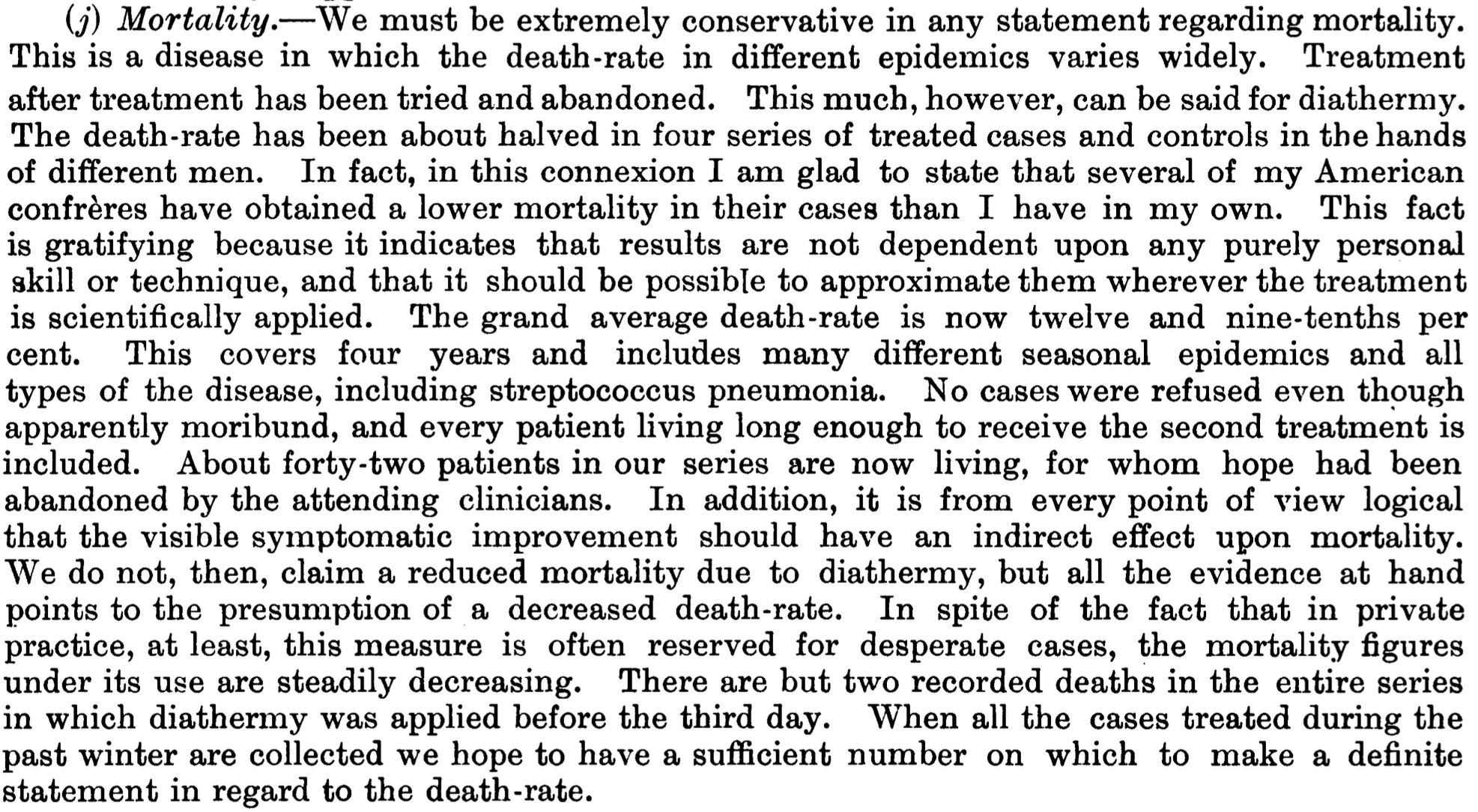
Diathermy in the Treatment of Pneumonia
, H., Proceedings of the Royal Society of Medicine, 19:53-56, Dec 1926
53rd treatment shown to reduce risk in
December 2023, now with p = 0.026 from 4 studies.
Lower risk for recovery.
No treatment is 100% effective. Protocols
combine treatments.
6,300+ studies for
210+ treatments. c19early.org
|
Report on the use of diathermy in the treatment of pneumonia in 1926, with case reports from several physicians covering over 300 patients. Author reports that diathermy had consistent positive effects without significant adverse events, resulted in about half the mortality of the control group, significantly alleviated symptoms such as dyspnea, pain, and cardiac strain, and improved sleep and reduced respiratory rates.
Stewart et al., 31 Dec 1926, retrospective, peer-reviewed, 1 author.
5ectton of flectro-Eberapeutics
CREDIT for the earliest attempt to use diathermy in the treatment of pneumonia apparently belongs to two American workers, Frederick DeKraft and Byron Sprague Price, of New York, about the year 1906. The former confined his work to the attempt to obtain early resolution in several cases in which it was delayed, and in 1913 he gave instructions for its use on himself during a severe attack of lobar pneumonia. Dr. DeKraft later described symptomatic relief similar to that obtained in our own treated cases. Dr. Price treated a number of cases, diagnosed as pneumonia, by diathermy in conjunction with the superheated dry air oven bath for elimination, reporting the work in general terms in 1916. In none of this work was there any attempt to type the organism, obtain chest X-rays, or confirm the diagnosis other than clinically. The writer was unaware that any work had been done on the subject when the logic of it first appealed to him in 1921. There was in that year a severe epidemic in the U.S. Marine Hospital 21, New York, which he attended in the capacity of consultant in physiotherapy. After a conference with the commanding officer, Colonel George B. Young, and his clinical staff, it was decided to try diathermy experimentally, upon our assurance that with careful technique it was reasonably safe. However, the institution of this experiment was postponed until we had a case in which we believed there was otherwise no possible chance of recovery. This case-that of a merchant seaman in the eleventh day of a creeping involvement of the lobes-was believed to be hopeless, and the patient's family had been so informed. He was given a through-and-through antero-posterior diathermy with bare composition metal plates, 2,000 ma. for twenty minutes. The result of this treatment was, indeed, beyond our most sanguine expectations. His clinical improvement was immediate and marked, and he made an uninterrupted recovery with subsequent treatments given twice daily. It was realized that this result might have been accidental, but we were greatly encouraged to continue the work. In order to make our study of scientific value and justify its acceptance by the profession, the following plan was evolved. Each case was studied, written up, and checked by the medical staff. X-ray and laboratory reports were made by the regular staff, and no change from the usual medicinal, nursing and dietetic care of the patients was made. In our series of the next twenty cases so treated we had but one fatality, a case obviously moribund from the start. It was the desire of the medical staff, after the results demonstrated in this preliminary series, to apply diatthermy in every case as soon as the diagnosis was made. It was felt, however, that there was need for the study of a control group, so for the remainder of the season every third case was used as a control. The patients were chiefly all merchant seamen, whose age, alcoholic history, and conditions of life were practically..
